Key Skill: Every Move Creates a Weakness

1.e4 e5 2.Nf3 Nc6 3.d4 exd4 4.Nxd4 Bc5 5.Be3 Qf6
There’s a saying in chess that “every move creates a weakness.” This interesting opening is based on the weakness of c7 after Black plays …Qf6.
Use the PGN player on the right column to play the game as you read the article. On small devices, the player may be placed at the bottom of the article.
6.Nb5 Bxe3 7.fxe3
Key Skill: Evaluate tradeoffs
The ability to “evaluate tradeoffs” is an important part of chess skill.
Either consciously or unconsciously, chess players continuously assess the importance of time, space, and force. The relative importance of each of the elements shifts frequently throughout the contest, and it’s vital to factor this into our analysis.
In this opening, White trades off the permanent weakening of his pawn structure for long term pressure against the dark squares.
This theme of weak dark squares consistently presents itself throughout the contest. It colors every single variation and it is the dominant theme in this game.
Key Concept: Understand Imbalance
In the current game, we are now presented with a highly unbalanced position, and imbalance creates opportunity. It represents a slippery slope that your opponent must carefully navigate in order to maintain equality. We’ve already reached an extremely unusual position, and it’s only move 7.
Key Concept: Understand Your Opponent’s psychological state
It’s always good to make your opponent face hard decisions.
There’s 3 separate lines in this position
7… Qxb2 7… Qh4+ then …Qd8 7… Qh4+ then …Qxe4.
Black took almost 20 minutes to make his move, as he wandered through the maze of possibilities.
That’s another good thing about giving your opponent hard decisions to make. They spend a lot of time thinking. There’s only so much mental energy to put into a game, and there’s only so much time on the clock.
Let’s see how the contest unfolds.
7…Qh4+ 8.g3 Qxe4 9.Nxc7+ Kd8 10.Nxa8 Qxh1 11.Qd6 Nf6 11. Nge7
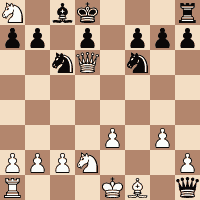
This knight move leads to a colorful sequence I’ve had the opportunity to play in several speed games.
12.Nd2 Qd5
This is is definitely “the most natural move.” The problem is that sometimes “natural moves” don’t work. That’s why we must always remain vigilant, and look deep to see the true reality on the board.
13.Qc7+ Ke8 14.Qxc8+ Nxc8 15.Nc7+
winning a piece and the game.
12.Nd2 Qd5 13.Qc7+
Key Skill: Dominate Squares of a certain color.
We’re still “in book” and you’re looking at a known variation.
At this point it becomes useful to note that when White captured on c7, the d6 square became a beautiful occupation point for his queen.
A large number of grandmaster games involve dominating squares of one color. In chess terminology, this is called “working a color complex” and you’ll often see grandmasters orchestrate numerous maneuvers through a color complex on their journey to victory.
13…Ke7 14.0-0-0 Qe5?
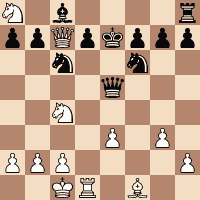
Given the pressure on his king and the surrounding dark squares, Black seeks to exchange queens. However, this move enables White to bring in a new piece, and he intensifies his control of the dark squares.
14…Qxa2 is considered “the mainline.”
15.Nb3 Qa4 16.Bg2
The position is almost completely equal, according to Fritz. Black has won a pawn, but his king’s position is shaky, his dark squares are weak, and he has trouble developing his queen bishop.
15.Nc4 Qxc7 16.Nxc7 h5 17.Nd6 g6 18.Bc4
Key Skill: Find a Way to Convert Your Advantage
A very deceptive move, and also very difficult to find. It was definitely the best move of the game.
I spent over 15 minutes looking for a way to convert my advantage. 18.Bc4 looks like a simple and direct attack against f7. However, the true purpose was to provoke …Ne5.
Now why would I want to provoke …Ne5?
Good question. You remember we said that every move creates a weakness, right? The point is that 18…Ne5 leaves a7 unprotected. In the vast majority of positions, that remote weakness would be unimportant. However, it becomes fatal when combined with the rest of White’s advantages:
- Extreme square control in the center and on the queenside, especially on the dark squares.
- Large development advantage.
- The landlocked position of Black’s light square bishop.
18…Ne5 19.Bb3
White is now threatening Ncb5, followed by Na7, winning the bishop.
19…a6
19…b6 was necessary in order to create a square for the bishop. Here’s a logical continuation: 20.h3 g5 21.Ncb5 winning the a pawn. Black can’t advance it, because Na7 wins the bishop. 21…Ba6 22.Nf5+ Kd8 23.Nxa7, with a winning advantage.
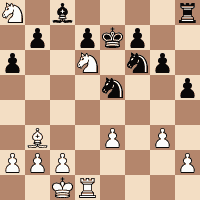
20.Na8 Nfg4 21.Nb6
The final and decisive “dark square occupation.”
Who could have ever predicted a maneuver like Na8-b6 would win the game?
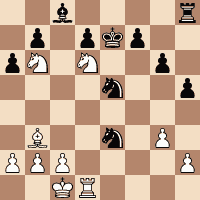
21...Nxe3 22.Nbxc8+ Kf6
and White won the game after 42 additional moves.
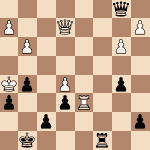
George is such a refined player! I have been blessed with many hours of one-on-one lessons with him. I have never experienced a source of dynamic attacks such as his scotch game.
chess isn’t all about winning it is about having fun and using the brain.